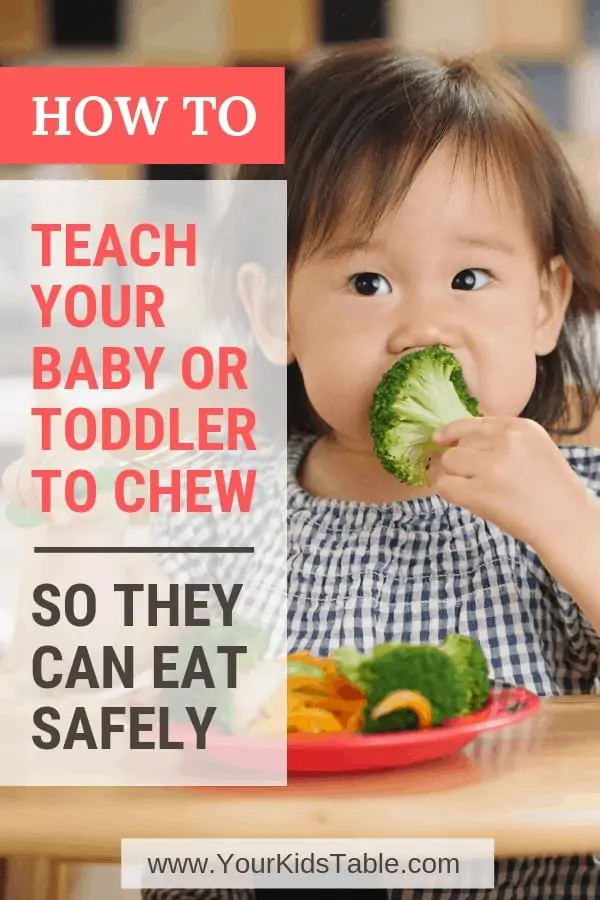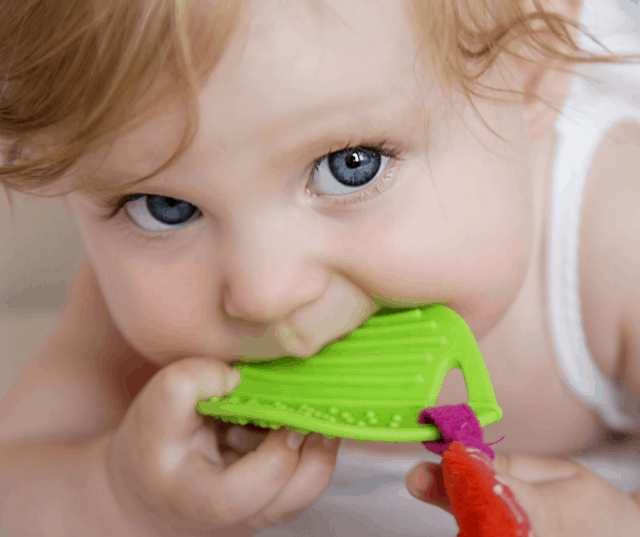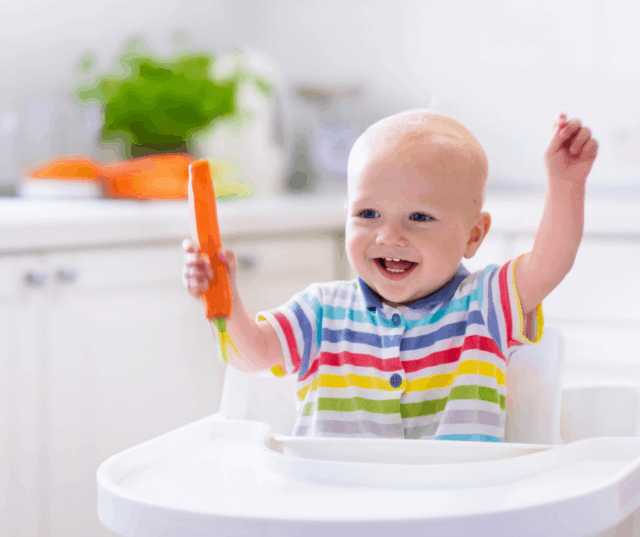Learn how to teach your baby to chew with these 5 surprising tips! I’m also talking about chewing problems in toddlers…
It’s one of those things we take for granted or don’t think about much. We assume our babies will know how to chew when it comes time to feed them. And, while that’s certainly the case for a lot of babies, it isn’t for all. Some babies seem to have no interest or can’t figure out what they need to be doing when that food hits their tongue.
Sometimes a little practice is all that’s needed, other times, it turns into a road block and a baby will want to keep sucking down their milk around the clock or swallowing mashed baby food whole.
But, chewing is important for babies and toddlers. And, just like walking and talking, you can teach your baby how to chew!
What If I Don’t See My Baby Chewing?
It’s important not to panic if you don’t see your baby chewing though. Sometimes, they really do need a little more time, especially if they were born at 38 weeks or less.
You’ll also want to make sure you’re watching your baby closely while they’re eating because it can be really easy to miss the little munching up and down inside their tiny mouths. Plus, you likely won’t see any chewing at all on baby food.
What you do want to see, even by 6 months old, is that they’re chewing on toys and teethers, frequently. And, if you don’t, then you’re in the right place to learn how to help your baby start chewing.
When Should a Baby Start Chewing?
Babies begin to chew on their hands, toys, and teethers around 4 – 6 months old. Typically, babies become obsessed with putting everything in their mouth. It’s a bit of a stressful time for parents because they won’t discriminate between that gross fuzzy or piece of dog food they found on the floor.
But, this is how they explore the world at this age, through their mouth!
As they put the toys into their mouth, you’ll probably see them moving it from side to side and biting up and down. They will get a lot of practice chewing like this so that, by 7-8 months, they are ready to begin chewing some real foods at meals.
Just like with any milestone, it’s totally normal for babies to need some more time. It may not be until 9 or 10 months when they figure the whole chewing thing out. But, we do look for chewing and eating table foods by 11 months.
The cool thing is that if babies have practiced chewing on teethers and toys, there’s a window between 8 and 11 months when they instinctively know how to chew. That’s not to say they’ll never chew if they haven’t begun by 12 months or later, but it will take more direct teaching. That’s where the tips below will be even more critical!
Check out Feeding Milestones to learn more about when your child “should” be eating what.
Affiliate links used below. See our full disclosure.
5 Tips to Teach Baby to Chew
These tips will set the foundation for and help your baby learn to chew. They’re perfect whether you’re looking to take a proactive approach and help your baby transition smoothly to eating table foods, or, if your concerns are growing because your baby, or toddler won’t eat or, isn’t chewing yet.
If you’re in the latter situation, these tips are just the tip of the iceberg, there are more advanced strategies. If you feel you need more support, as an occupational therapist myself, I’d recommend looking into feeding therapy.
1. Use Teethers and Toys: As you just learned, all that practice babies do while chewing on teethers and toys is important. It’s laying the groundwork for them to eventually eat foods. But, some babies skip this step. Sometimes, it’s because of the way toys feel in their mouth and they don’t like it so they avoid it, this is due to their sensory processing. If you suspect this is the cause, then read more in sensory issues with food.
Other babies avoid teethers because it’s tiring and difficult. In this case, it’s probably because of their oral motor skills.
And yet, other babies won’t use them because they just aren’t interested. No matter what the reason is, it’s important that you encourage and demonstrate chewing on teethers often.
If they allow you bring the teether up to their mouth, or if they like baby food, you can even dip some of the teether into the baby food for them to lick off! Try different styles of teethers and toys, there are a ton. This is one of my favorites.
Head over to Why Your Baby Should Be Putting Toys in Their Mouth for more.
2. Practice on Large Foods: If your baby won’t go for the teethers, another option is to use large pieces of food that they can’t eat, but can mouth on. Think about a whole, peeled carrot or a long stalk of celery. Again, you can dip these in baby food or just let your baby explore it.
Use these large pieces of food while they’re seated in their high chair, at the same time you’re eating! If your baby already has teeth, make sure they can’t get any pieces off though, if they can, you’ll have to skip this step because they don’t have the skills to chew hard foods like that yet.
3. Demonstrate: You’ll be putting yourself ahead of the game if you can coordinate when your baby is eating, even if it’s just baby food, with your mealtimes. When you have just one child it can be tempting to feed them at a separate time, but in that shared meal time, they are learning a lot.
Not to mention that down the road it will save you frustration over getting them on a mealtime routine.
Plus, as you sit and eat together your baby is watching you, even if it seems they aren’t. They are see how you chew and will want to imitate it. To really show them how to chew, you’ll want to put one piece of food in your mouth at a time and dramatically chew for them – WITH – your mouth open.
Yes, I know it’s gross, but nobody else is watching, and if they are who cares, you’re teaching your baby!
4. Brush Their Gums/Teeth: One of my favorite tips to encourage chewing is to start brushing your baby or toddler’s gums 2 times a day with an infant toothbrush, like this one. While this sounds like a strange suggestion, it helps them get used to having something else in their mouth and it stimulates movement in their tongue.
Tongue movement is critical for chewing, and many kiddos struggling to chew aren’t moving their tongue well.
This brushing, with a firm pressure, also prepares the mouth for accepting more textures and even helps to desensitize the gag reflex!
5. Give Them the Right Foods: Lastly, once they are around 8 months old, it’s time to start trying some real foods. You’ll want to skip stage 3 baby foods that have the mixed chunks in them. That’s a difficult texture for a lot of babies, some will gag, some will throw up, and some will spit out the chunks or hold them in their mouth.
Instead, you’ll want to focus on crunchy foods that melt easily. Think puffs, graham crackers, and rice husks. In any grocery store you can find a mountain of these stage 1 table foods that are perfect to help babies learn to chew.
Head over to how to transition to table foods to learn next steps.
Chewing Problems in Toddlers
It’s common for me to see toddlers that missed that window for learning to chew and are still struggling to at up to 2 years old and even beyond. If that’s your child, know that it’s never to late to teach them how to chew.
For one and two year olds specifically, all of the above tips are still appropriate and will help bridge that gap to chewing. But, if your child is over 12 months and is only drinking milk or eating baby foods, it’s time to look for some more help. If you’re in the states, you may qualify for free early intervention.
And, the same difficulties I listed above for babies not wanting to chew on teethers, applies to difficulty eating. It could be sensory, oral motor, or even medical based. You can learn more in 5 Reasons Kids Don’t Eat.
Get More Help in This Free Workshop
To learn more about teaching your baby to eat, grab a free seat in my workshop: 5 Easy Changes Parents Can Make To Help Babies & Toddlers Eat Table Foods Well! You’ll learn exactly what NOT to do and even more tips to get your baby or toddler on the path to eating well. We’ll send you a free printable workbook in your inbox too!
Click here to get your seat now!
More on Feeding Babies and Toddlers
Self-Feeding: The Complete Guide for Babies and Toddlers
Why You Should Let Your Baby (or toddler) Get Messy Eating
Does Your Baby or Toddler Keep Spitting Out Their Food? Try This!
Alisha Grogan is a licensed occupational therapist and founder of Your Kid’s Table. She has over 19 years experience with expertise in sensory processing and feeding development in babies, toddlers, and children. Alisha also has 3 boys of her own at home. Learn more about her here.





My little Ken just turned a year old.
She’s been introduced to solids since she was 4-5 months old following closely with BLW.
As she’s continuing to eat more and more foods, she is still not wanting to chew her food and just swallow the small pieces whole. It’s at the point where she throws up a little after eating and there are chunks of food.
I’m not sure what to do. She loves food, and was introduced early.
I’m not sure what to do anymore. My daughter will be 4 in a couple months and still doesn’t know how to use her molars. She got introduced to solid foods late because her teeth didn’t come in until 15 months and I was scared she would choke. She missed a very important window that I had no idea about at the time and I feel terrible. She eats very soft textured foods that are easily swallowed. I’ve seen her use her front teeth sometimes, but in a robotic cartoonish way. I also have a hard time brushing her teeth because she thrusts her tongue out and covers her teeth with her lips. She’s been seeing occupational therapy since she was 2 with very little progress made, and speech at 3 with the same results. If anybody is going through something similar I’d really appreciate your comments and how you’re working on resolving the issue.
Hi Madison,
It can feel so frustrating and hopeless when you’ve been seeking support and not getting anywhere. Has she been diagnosed with an oral aversion? This is what it sounds like to me. We have an article on oral aversion that may be helpful, check it out and feel free to comment back and we can go from there.
Best,
Laura
Your Kid’s Table team member
Hello,
I’m new to this page.
My daughter is 2.5 yrs old. She didn’t learn to chew food. She doesn’t eat any solid foods. She will ear puree food’s only. We are seeing occupational therapist but they are doing really nothing except giving lectures and advice. We follow what they say but she doesn’t eat anything at all! She drinks milk thats it!!!! If someone could help me here. Really appreciate it!
Hi Sonal,
Since you are new, check out our picky eater free webinar to start. This will give you a background on our philosphy of using no pressure and providing variety once you identify the underlying cause of the picky eating. We have one for starting solid foods that is geared toward younger babies and toddlers but I’m going to link that too if you think it’s a better fit. Once you watch those, I’m happy to direct you to some other resources that may really help! Cutting down on the milk will be one of the first steps, and we have a few articles on that.
Best,
Laura
Your Kid’s Table team member
Hello. I have twins that were born 2 month premature. They’re 15 months now and eat a decent about of solids. One twin hold food in her mouth and may or may not swallow it. Shell put the food in her mouth, hold it in there, and cry when its full if she doesnt want. Definitely doesn’t do a lot of Chewing. She really didn’t use a teether or suck on a pacifier [past 6 months] We are trying to wean them off the bottle and be completely on sippy cups [or strawed]. We use a U shaped toothbrush daily. Should we switch to a regular toothbrush ? We’ve tried a few of your tips above.. nothing. Please help! Ty.
Hello, I would definitely try a regular toothbrush. The pocketing and holding food also sounds like she has low registration for her mouth and what is in it. You might find this article helpful on the topic.
Best,
Laura
Your Kid’s Table team member
Hi
I have a 8 months old and he is struggling to swallow any solids like small pieces of bread. He will act like puking as soon as any regular solids is in the mouth. So he is mainly getting the porridge now. Another thing is he is not very interested in kind of food, solids or liquids. Any suggestions for the help would be wonderful.
Love
Nidhi
Nidhi,
Check out our free workshop on solids if you haven’t already. It will give you some ideas as a starting point.
Best,
Laura
Your Kid’s Table team member
My son is 3and 6months and do not know how to chew. I have to purée all his food in other to get the required nutrients. Pls help me.
Hi Akos,
Besides the tips in this post, it’s possible your son needs help building oral motor skills to chew. Try the tips here first, but then you can check out this post on motor skills to work on. You should be able to slowly add texture to the purees with enough exposure and consistency.
Best,
Laura, Your Kid’s Table team member
My girl is 15.5 mo and isn’t chewing some foods (most) properly. She will try to swallow whole pieces of pasta without chewing them. It has been something she has often done but we feel it is getting worse. She is now panicking and slamming her hands down on her highchair in panic because the food is stuck in her throat. We are then also panicking.
She has FPIES so her whole weaning process has been slow and very challenging resulting in fussy behaviours, plus she has a difficult temperament so she barely lets us brush her teeth which understand could help.
We are awaiting an appointment with the SALT team but in the meantime we are tempted to start blending her food again to make it safer for her to eat as she doesn’t seem to have any problem swallowing yogurt or porridge.
We are not even sure if she will accept this as we have tried to chop her pasta up into tiny pieces but she is now refusing to eat this as she doesn’t not like the consistency.
She tends to chew crumpets quite well but that’s as far as it goes in terms of actual solids.
She even tries to swallow her corn melty snacks before they have melted down properly.
We have tried her very best to over exaggerate our chew but she is now getting cross at us when we tell her to chew, and she ends up getting upset.
We don’t want to make the situation worse but it is terrifying seeing her in panic and discomfort.
It is very stressful to say the least, especially with her FPIES as she already has a very limited diet 🙁
Thank you in advance
Hi there! Thanks for reaching out! We definitely recommend consulting with your pediatrician regarding this issue. Your pediatrician can then refer you to a feeding therapist for some hands-on help. In the meantime, practice with some sensory and oral motor exercises by using sensory bins, food play, and allowing her to touch/feel/play with her food. Try using a toothbrush to brush the insides of her mouth before mealtimes. Other oral motor exercises include making silly faces, blowing bubbles, sipping from straws, and licking lollipops/popsicles. These exercises will help strengthen her oral muscles, which are what she uses to chew/swallow her food. Keep practicing and demonstrating the way youre currently doing— over exaggerating chewing/eating motions as she watches you! We have more tips here!
Best,
Kalyn
My son is now 11 months, has been chewing and eating table food for months, but nearly all his remaining teeth came in at the same time about a week and a half ago. He is chipmunking his food and pulling it out because he is biting his tongue repeatedly. He went from eating half a pork chop to nearly nothing but bottles. How do we help him adjust to his new mouth full of teeth so he stops hurting himself? In addition, he wants to feed himself so puréed baby food just makes him mad.
I will add, he chews on everything! He “brushes” his teeth. Has a dozen chewy things because getting all your teeth at once hurts! He eats at the table with us. He will even eat the meat directly off a rib bone. … but the last 10 days with his new mouth full of teeth … biting his tongue and crying only with food not the toys and such.
I will add the he chews on everything. Dozens of teethers, silicon straws, leather belt pieces, and even his tooth brush because well getting all your teeth at once hurts!! He eats at the table with us.
Hi Rachel! Thanks for reaching out! This is such a common problem with teething! Keep offering those teethers for him to chew, keep brushing his teeth, and continue to offer solids/textures as per usual! He may just need some more time to adjust. Don’t force or pressure— just place the food in front of him and allow him to feed himself. We have a blog about food pocketing you can also check out, here!
Best,
Kalyn
Good afternoon,
My son is 13 months and would buy out anything in his mouth with a texture besides his bottle and pacifier.. he would he stage 2 foods just fine but when we started to try puffs or anything like that he would gag and throw up or just spit it back out. Prob about 3 weeks ago he finally started being interested in the foods we are eating and will now put things in his mouth.. we do practice chewing when he is eating and I show him the movements for his mouth and he does it with me..however he just holds the foods that don’t dissolve in his mouth and then will spit it out after so long.. and tips on how to get him to actually swallow the textured foods?
Hi Alisha! Thanks for reaching out! Keep practicing and demonstrating the way youre currently doing— over exaggerating chewing/eating motions as he watches you! You may also try some oral motor exercises, like using teethers or a toothbrush to brush the sides of his mouth. This will help strengthen his oral muscles. We have more tips here!
Best,
Kalyn
Hello, my daughter is 11 months and we are working on transitioning to table foods. It has been a hard journey for me because she has a very sensitive gag reflex and would throw up with any table foods just up until a few weeks ago. She loves purées and specifically pouches. She is starting to put table foods in her mouth but spits them out and is mainly exploring. Chewing happens sometimes but not all the time. We have an appointment with our peds next month. She is also still breastfed. Any advice? Thanks
Hi Whitney! Thanks for reaching out! It sounds like she’s making progress, so that’s great! Keep allowing her to explore these foods and textures- letting her touch/feel them and feed herself. To help with her gag reflux, try using a toothbrush to brush the sides of her mouth. This will help to strengthen her oral motor muscles and desensitize her gag reflux! For more help, check out our free table foods workshop- save your seat here!
Best,
Kalyn
Hi there, my daughter,is 2 years 6 months now she fails to pick foods on her own and to chew pliz help.
Hi there! Thanks for reaching out! Because of her age, we’d definitely recommend consulting with your pediatrician regarding this issue. Your pediatrician can then refer you to a feeding therapist for some hands-on help. For more information about feeding therapy, click here! She may need help with chewing/swallowing. In the meantime, practice with some sensory and oral motor exercises by using sensory bins, food play, and allowing her to touch/feel/play with her food. Try using a toothbrush to brush the insides of her mouth before mealtimes. Other oral motor exercises include making silly faces, blowing bubbles, sipping from straws, and licking lollipops/popsicles. These exercises will help strengthen her oral muscles, which are what she uses to chew/swallow her food. Hope that helps!
Best,
Kalyn
Hey my baby is 2 years now but he takes time to chew food sometimes he takes hour putting food in the mouth
Hi there! Thanks for reaching out! We know how stressful eating issues can be. We definitely recommend consulting with your pediatrician regarding this issue. Your pediatrician can then refer you to a feeding therapist for some hands-on help. In the meantime, practice with some oral motor exercises- we have a post for that here! Try using a toothbrush to brush the insides of his mouth before mealtimes. Other oral motor exercises include making silly faces, blowing bubbles, sipping from straws, and licking lollipops/popsicles. These exercises will help strengthen her oral muscles, which are what we uses to chew/swallow our food. Hope that helps!
Best,
Kalyn
Hi
My son is 5 years old and he still only wants baby purée food for dinner and breakfast. He can eat sum hard foods at lunch times like cheese cookies potato chips and muesli bars. At dinner time if you put food in front of him mashed or cut small or whole he wants to run away. He can’t even stand to look at it. It’s like he’s got a good phobia or sumthing. Please help us if you have any thoughts on getting him to eat normal food that isn’t purée.
Hi Richard! Thanks for reaching out! That sounds super challenging. You can discuss this further with your child’s pediatrician, but since he seems to do fine with some different textured foods, it may be less of a chewing problem and more of a picky eating problem. For that, we always recommend promoting a no-pressure environment- allowing him to eat as much or as little as he wants. Try serving him the same foods at mealtime as everyone else, but pair it with at least one of his favorite foods. Our free picky eating workshop would be a great place for you to start to get some more ideas and help. You can save your seat here!
Best,
Kalyn
Hi my daughter is above 2 year old she has same problem she doesn’t eat solid food..she eat baby food puris.. I m worried about dat plz help me…or she doesn’t even interest picking food..plz plz help me ….
Hi Nana! Thanks for reaching out! We know how stressful eating issues can be. We definitely recommend consulting with your pediatrician regarding this issue. Your pediatrician can then refer you to a feeding therapist for some hands-on help. For more information about feeding therapy, click here! Since she’s stuck on purées, she may need help with chewing/swallowing. In the meantime, practice with some sensory and oral motor exercises by using sensory bins, food play, and allowing her to touch/feel/play with her food. Try using a toothbrush to brush the insides of her mouth before mealtimes. Other oral motor exercises include making silly faces, blowing bubbles, sipping from straws, and licking lollipops/popsicles. These exercises will help strengthen her oral muscles, which are what she uses to chew/swallow her food. Hope that helps!
Best,
Kalyn
i have a boy that is severely developmentally delayed and doesnt know how to chew at all. what can i do? i know i need massive help but im not sure where to go or who to contact for help on this…..
Hi Joshua! Thanks for reaching out. We understand how stressful it can be, but you’re definitely not alone! We would recommend consulting with your pediatrician, who can then refer you to an Occupational Therapist or Speech Language Pathologist to start feeding therapy and work on his oral skills. We have a post all about feeding therapy that you can read here!
Best,
Kalyn
My baby is 17 months and still eating purée food he wont touch any solid food im so stressed and helpless plz plz help me
Hi Bimala! Thanks for reaching out! We know how stressful eating issues can be. We definitely recommend consulting with your pediatrician if possible, since they can refer you to a feeding therapist for some hands-on help. Since he’s stuck mainly on purées, he may need help with chewing/swallowing. In the meantime, practice with some sensory and oral motor exercises by using sensory bins, food play, and allowing him to touch/feel/play with his food. Try using a toothbrush to brush the insides of his mouth before mealtimes. Other oral motor exercises include making silly faces, blowing bubbles, sipping from straws, and licking lollipops/popsicles. These exercises will help strengthen his oral muscles, which are what he uses to chew/swallow his food. You may also try demonstrating eating/chewing by having him watch you make the over-exaggerated motions, or even use toys to demonstrate feeding and having him practice feeding the toy. We also have a free workshop that can help with eating table foods- save your seat here!
Best,
Kalyn
Our 16-month-old boy eats all the foods we eat except that he doesn’t chew them. He will swallow them whole so we have to cut everything small. He does know how to chew though because if we give him a carrot or a cucumber or celery he will chew on it and swallow pieces. Just getting him to chew everything rather than swallowing whole is the challenge.
Hi there! Thanks for reaching out! We know how stressful eating issues can be. Keep practicing and demonstrating the way youre currently doing— over exaggerating chewing/eating motions as he watches you. Also, practice with some oral motor exercises- we have a post for that here! Try using a toothbrush to brush the insides of his mouth before mealtimes. Other oral motor exercises include making silly faces, blowing bubbles, sipping from straws, and licking lollipops/popsicles. These exercises will help strengthen her oral muscles, which are what we uses to chew/swallow our food. Hope that helps!
Best,
Kalyn